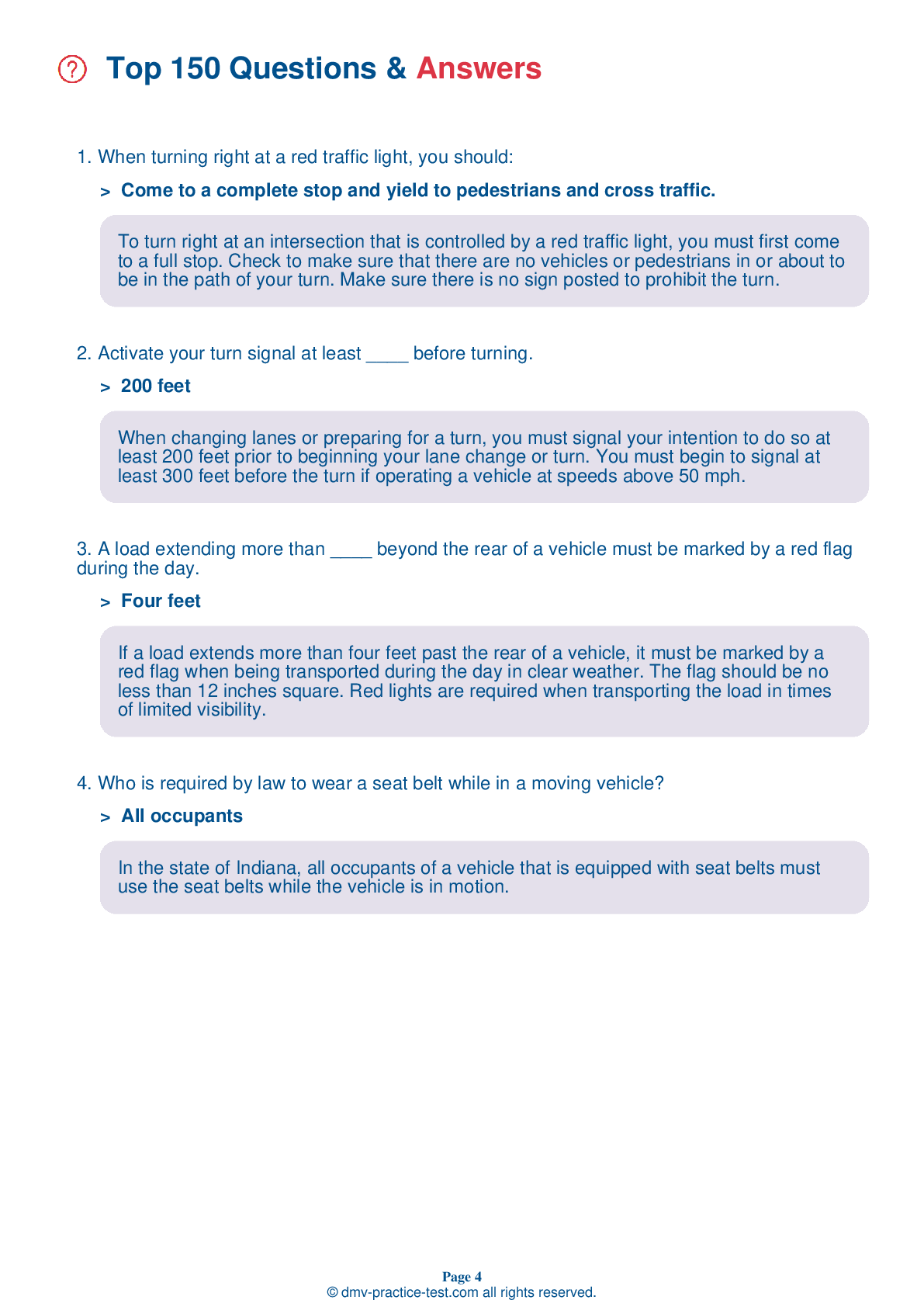FREE Indiana DMV Practice Test #14 Page 5 of 5
This set of Indiana DMV practise tests has been updated for January 2025. It includes questions based on the Indiana Driver Handbook's most significant traffic signals and laws for 2025. Use actual questions that are very similar (often identical!) to the DMV driving permit test and driver's licence exam to study for the DMV driving permit test and driver's licence exam.
On the practise exam, each question gets a tip and explanation to help you remember the concepts. The written component of the official Indiana DMV test will include questions about traffic rules, traffic signs, and driving statutes, as well as information from the Driver Handbook.
To obtain a passing grade, you must correctly answer 44 of the 50 questions. Take our DMV practise exam to help you prepare for your Indiana instruction permit or driver's licence.
The DMV exam is available in several languages.
Using any kind of testing assistance will result in an automatic fail, and the DMV may take additional action against your driver's licence, so stay away from it.
39 . What should you do when you are going to enter a roadway from a private road?
When entering a roadway from a driveway or private road, you must yield the right-of-way to pedestrians and traffic on the roadway.
40 . When passing a large vehicle, the driver of a small vehicle must be prepared for:
Large vehicles can cause wind gusts with a force great enough to cause direction changes in smaller vehicles. Drivers of small vehicles should be prepared to take proper corrective steering action when approaching or passing large vehicles that are moving at or near maximum speeds.
41 . Which statement about speed is true?
As speed increases, the chance of a fatality increases. If you are moving faster than 80 miles per hour, you have almost no chance of living through a crash. Driving more slowly than other traffic can also be dangerous because other motorists may become impatient and make dangerous moves to pass you.
42 . As alcohol builds up in your blood, it:
As alcohol builds up in your system, it will slow your reactions, make you feel more confident, and cause you to make more errors.
43 . This sign means:

Warning signs prepare drivers for upcoming road conditions and hazards and are usually yellow with black markings. This sign tells drivers that they are approaching a yield sign and should be prepared to come to a complete stop to yield the right-of-way to other drivers and pedestrians.
44 . This sign means:

This sign indicates that hospital emergency services are located to the right.
45 . Two solid yellow lines on the pavement mean:
Yellow lines tell you that the traffic on the other side of the lines is moving in the opposite direction. You should never cross two solid yellow lines to pass from either direction.
46 . When in a travel lane on the roadway:
You should not stop in a travel lane for any reason. Instead, keep moving until you can safely pull off of the road. If you miss your turn or exit, do not back up. Go to the next turn or exit or where you can safely turn around.
47 . When approaching a flashing red traffic light, drivers should:
Flashing red lights are used at dangerous intersections. Treat them like stop signs.
48 . What does a single dashed yellow line separating traffic mean?
Yellow lines separate traffic moving in opposite directions. A single dashed yellow line in the center of a road indicates that vehicles traveling in both directions are permitted to pass. Drivers may only begin a pass if they will not interfere with any oncoming traffic.
49 . A driver with a probationary license may use a telecommunications device while driving if they are:
In the state of Indiana, a person who who obtains a driver's license and is under the age of 21 is operating on a probationary driver's license. Probationary license holders may not drive while using any telecommunications devices, such as a cell phone, unless the device is being used to call 911 to report an emergency.
50 . You are coming to a railroad crossing where the crossing signals are flashing. You should:
When approaching a railroad crossing, you must stop your vehicle no closer than 15 feet from the nearest rail if an installed electric or mechanical signal is giving warning of an approaching train. Be aware of other warning signs that may indicate an oncoming train, including seeing a lowered crossing gate or hearing an oncoming train.
See the exact questions that will be on the 2025 Indiana DMV exam.
99.2% of people who use the cheat sheet pass the FIRST TIME
LT gives us an insight on how the cheat sheet provided her with all the study questions she needed before taking her test.
Joe initially studied with the handbook and failed his test, he eventually found us online, studied and pass his test the first time around.



